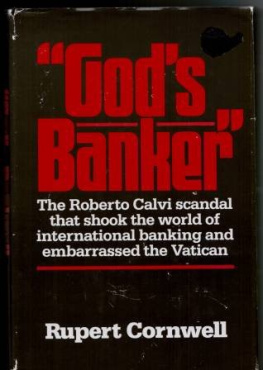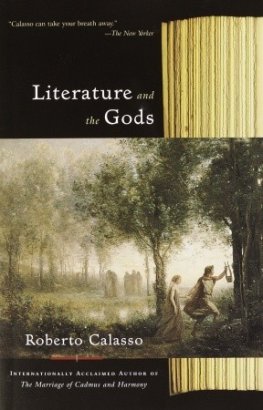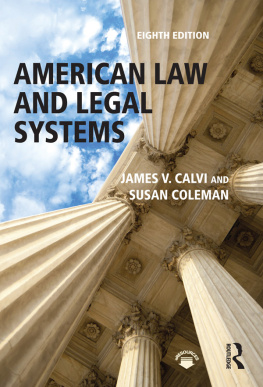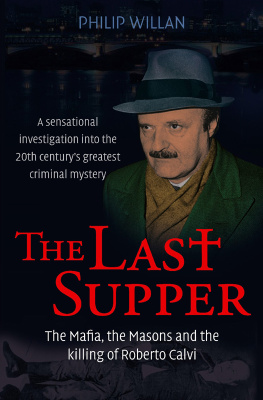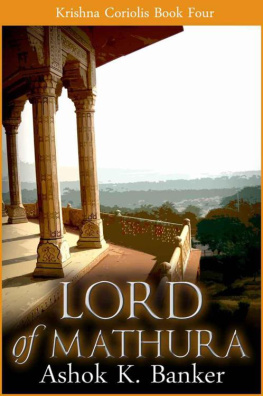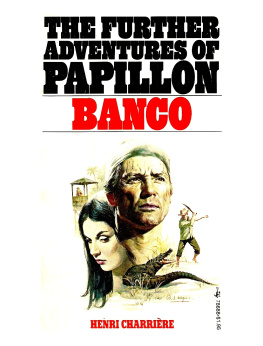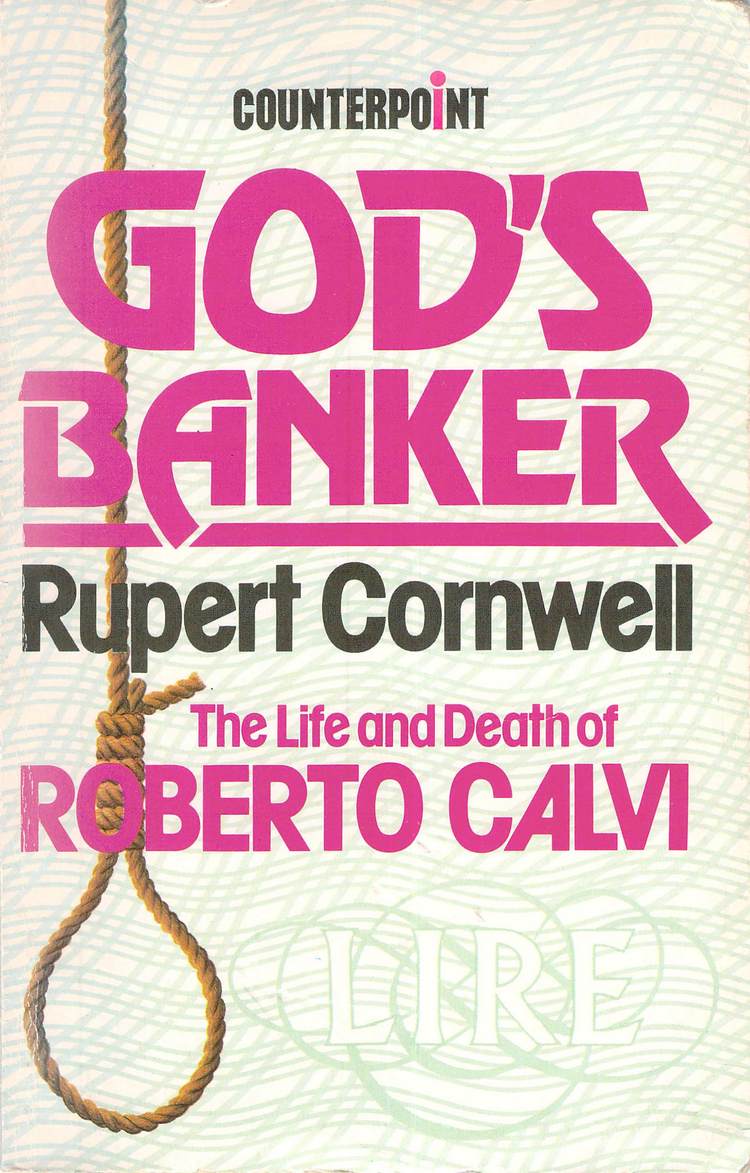
GOD'S BANKER
The Life and Death of Roberto Calvi Rupert Cornwell
The death in London by hanging of one of Italy's leading bankers, Roberto Calvi, focused the world's attention upon the affairs of the Banco Ambrosiano, a bank closely involved in Vatican finance. This bank, which Calvi had devoted his career to building up, was under heavy investigation at the time of his death, and Calvi himself had been charged with fraud and the illegal transfer, or misappropriation, of funds running into millions.
Following Calvi's macabre downfall, the Banco Ambrosiano collapsed, exposing the darker face of Italy, its financial and political intrigue, sinister secret societies, intimidation, blackmail and murder. The Ambrosiano affair shook the international banking system. It helped to expose years of reckless financial behaviour by the Vatican, calling into question the judgement of the Pope himself. Aspects of the affair have still not been explained: some probably never will be. But the broad outline of what happened is now clear.
After intensive research, including interviews with leading figures in the Italian financial world, with Cavi's family and associates in the United States and with bankers in the capitals of Europe, Rupert Cornwell, the Financial Times Rome correspondent, has been able to unravel the complex story of Roberto Calvi and his world, and to piece together this amazing chronicle of financial malpractice in high places.
For this Counterpoint edition he has up-dated and expanded the final chapters to take account of the latest developments in this extraordinary story.
GOD'S BANKER
Epimenides the Cretan said: all Cretans are liars. Was he telling the truth or a lie?
Euboulides, Greek Philospher, 4th Century b.c.
... Fare che diventasse per sempre - non piu una burla, no; ma una realta, la realta di una vera pazzia: qua, tutti mascherati, e la sala del trono, e questi quattro miei consiglieri; segreti, e - s'intende - traditori.
(. .. So that it might be no longer a joke; but a reality for ever, the reality of true madness. Here, in the throne room, with everyone masked; and these four secret advisors of mine - naturally traitors all.)
Pirandello, Henry IV.
Rupert Cornwell
The Life and Death of
ROBERTO CALVI
COUNTERPOINT
London UNWIN PAPERBACKS
Boston Sydney
First published in Great Britain by Victor Gollancz Ltd 1983
First published in Unwin Paperbacks 1984
This book is copyright under the Berne Convention. No reproduction without permission. All rights reserved.
UNWIN PAPERBACKS 40 Museum Street, London WC1A 1LU, UK
Unwin Paperbacks Park Lane, Hemel Hempstead, Herts HP2 4TE, UK
George Allen & Unwin Australia Pty Ltd., 8 Napier Street, North Sydney, NSW 2060, Australia
Rupert Cornwell 1983,1984
Condition of Sale. This book is sold subject to the condition that it shall not, by way of trade or otherwise, be lent, re-sold, hired out or otherwise circulated, without the Publishers' prior consent in any form of binding or cover other than that in which it is published and without a similar condition including this condition being imposed on the purchaser.
To Angela
isbn 0 04 332099 6
Printed in Great Britain by Guernsey Press Co. Ltd, Guernsey, Channel Islands
ACKNOWLEDGEMENTS
This book is drawn from three main sources: my own experiences and recollections as correspondent of the Financial Times in Italy, during the events described in the last two thirds of it; the work of colleagues in the Italian and foreign pressan irreplaceable support for the journalist everywhere; and direct interviews with and documentary assistance from many of those involved with the story of Roberto Calvi and Banco Ambrosiano. Numerous people have given their time to help with the book's preparation. I am deeply grateful to all of them, especially those who would have preferred not to discuss a subject they would best like to forget. Many of them too have specifically asked not to be mentioned; and obviously I must respect their confidence. For that reason I will mention none of them, as a partial list of thanks might only be misleading.
Those to whom I can express gratitude include my paper for allowing me to take a sabbatical at the ideal moment, as well as friends on its staff who gave hospitality and help. They include Duncan Campbell-Smith in London, Reggie Dale in Washington, Paul Betts in New York and Nikki Kelly in the Bahamas. In Italy, I would take the opportunity of acknowledging my debt to the excellent book already published on the Ambrosiano affair, II Banco Paga , by Leo Sisti and Gianfranco Modolo. Some of the other published works from which I have drawn are referred to in footnotes. Then I must thank Professor Luigi Spaventa, who kindly read the manuscript and made valuable suggestions and caught potentially embarrassing mistakes. Similar thanks, for similar reasons, go to Mary Venturini, my colleague in Rome, James Buxton, and to George Armstrong. A special affectionate word must be kept for Nicoletta Rosati, our secretary in the Financial Times Office in Rome. She not only typed out two thirds of the
manuscript, but also produced some precious and, she will not mind
my saying, very Roman insights into an uncommonly complicated tale.
This book is an effort to provide a reconstruction that is at least understandable. Inevitably however, I will have made errors. I apologize for them in advance, offering in my defence only the observation that the book has been written in good faithnot the most conspicuous quality in the Calvi story.
Finally a brief note about the currencies referred to throughout the book. To avoid unmanageable strings of noughts, I have used the American billion in preference to thousands of millions, where the Italian lira is concerned. Between 1970 and 1982, the value of the pound varied between a low of around 1,400 lire and a peak of about 2,400 lire. The simplest, if rather rough, average conversion rate would perhaps be 2,000 lire. The lira/dollar rate has risen even more sharply. Between 1970 and 1975 the dollar stayed within the range of 580 to 680 lire. In 1976 it jumped at one stage to 900 lire. Over the next three years the rate declined to 780 lire. But from 1980, the dollar began an ascent which was showing no sign of abating during the time of writing. By early June 1983, it had passed the 1,500 lire mark.
Rupert Cornwell
CONTENTS
Some of the Cast 14
Introduction 19
The Beginning 27
Sindona 36
Freemasonry 44
Vatican 51
Empire Building 59
Rizzoli 74
Revenge 80
Inspection 86
The Bank of Italy Affair 98
New Ploys 108
Messages from Licia 118
Corriere 129
Prison and Trial 138
Letters of Patronage 146
The Man from Olivetti 155
The Last Illusions 163
Carboni and Flight 174
Week of Fire 185
Death in London 193
Clearing up the Mess 206
Aftermath 217
Vatican Disarray 225
The Vatican and the Money 231
Epilogue 238
Conclusions Appendix Index
Some of The Cast
Andreatta, Beniamino : Born 1928. Professor of Economy at Bologna University. Since 1976 a senator for the Christian Democrat party. Named Budget Minister August 1979. Between October 1980 and November 1982 Minister of the Treasury. He ordered the liquidation of Banco Ambrosiano.

